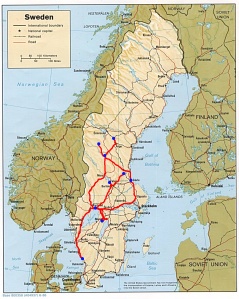
Spiterstulen mountain station is a popular starting point for the trek both up to Galdhøpiggen as well as the second highest mountain, Glittertind.
Norway is often considered one of the most beautiful places on earth. The fjords, valleys and high mountains make the country a marvel to behold. I went there on a five day expedition between 11-15 July. The mission? To climb northern Europe’s highest peak – Galdhøpiggen.
My partner for the trek is Linnéa, a biologist specialized in large carnivores and reindeer.
Galdhøpiggen is 2 469 meters above sea level. The peak is surrounded by a dramatic landscape and Jotunheimen National Park – protecting this pristine environment.
Approaching Spiterstulen mountain station, the “Oh’s” and the “Ah’s” come more and more frequently as the mountains next to us grow steeper and steeper. We see waterfalls and glaciers on both sides. We have a brief lunch by the river, pack our gear and begin the ascent.
The mountain walls are steep. We need to stop to catch our breath every once in a while. We encounter the first snow a few hundred meters up. Surprisingly, we also see domestic sheep grazing on the mountain. Norway is home to more than two million free-ranging sheep. It is one of the main reasons why the Norwegian government has decided only to have three wolf packs in the entire country; the rest are shot. The country is also home to a lot of free ranging semi-domestic reindeer and free ranging cattle.
The route we follow does not involve crossing a glacier but if you come in from the north then you need a special guide to cross it as there are glacial cracks in some places. These cracks appear to be more than ten meters deep in some places – possibly much deeper.
We continue upwards on the barren rocks. The vegetation is now only lichens. Thunder can be heard from the north and we see clouds carrying rain all around us. Yet the sun is still shining. There are a few steep areas along the way which provide excellent views. As we approach the peak we need to cross the top of one of the glaciers. I have been up in the Himalaya but never before stood upon a glacier. It is a great sight and amazing to see snow in the middle of July. Due to global warming the glacier on the second highest peak in Norway, Glittertind, has shrunk about ten meters. The debate on which peak is the highest has therefore been settled in favor of Galdhøpiggen.
It starts raining just as we reach the peak. There is a small rock-cabin on the peak where you can rest and buy hotdogs and postcards. We hurry up to the top and take a few pictures before the rain intensifies and thunder starts striking around us. We go into the cabin to rest and have a few well-deserved peanut butter sandwiches. Peaking out through the window, we can barely see more than 50 meters. We are literally up in the clouds.
We wait until the rain has eased. Linnéa takes on her jacket and hat as we go outside of the cabin to begin the descent.
“It feels like I am being bitten by an insect”, she says.

I have never – ever – seen such a big spruce tree! This picture was taken on 14 July on a trail outside of Lom in Norway. This country has amazing old growth forests leaving Sweden far behind in terms of forest conservation.
And then another, and another. The static electricity up in the cloud is literally charging her clothes making for a really eerie experience. We quickly go back into the cabin and wait a little longer. On the way down we are joined by a nice architect couple from Czech Republic. The descent is made easy by sliding or jumping on the snow. We do, however, come across an incident where a woman has fallen on a rock and has to be rescued by helicopter.
We spend the next days in Norway relaxing, doing a short trek up on another alpine mountain, seeing old-growth forests, waterfalls and other experiences making a visit to Norway worthwhile.






